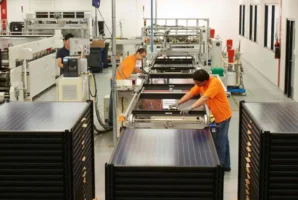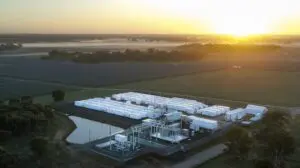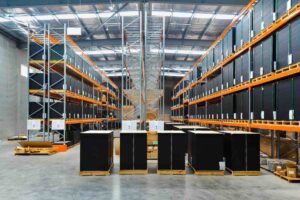Australian PV innovator 5B has announced a $33.4 million plan to fast-track the delivery of ultra-low cost solar power on a potentially massive scale, via dramatic improvements in the scalability and cost of its prefabricated, rapidly deployable Maverick technology.
5B said on Tuesday that the program, backed by a $14 million grant from the Australian Renewable Energy Agency, would leverage advanced automation – including cutting edge solar farm building robots – to make it faster, lower cost, more efficient and safer to develop large-scale projects.
Having delivered 32MW of capacity to clients since its first project in 2017, 5B is increasingly looking at “gigawatt” scale projects around the world, including at Sun Cable in Australia’s Northern Territory, where up to 20GW of solar will be built to export power to Singapore via a sub sea cable.
The company’s Maverick solution can already be deployed up to 10 times faster than conventional ground-mounted PV panels, and its concertina-style design means it can generate up to twice the energy using the same amount of land as conventional solar.
But the company believes it can – and must – “dramatically improve” on these metrics, in order to cater to the almost unfathomable scale of the Australian market, as it looks to not only meet its electrical needs with renewables, but to export clean power.
The federal government has recognised this, too, and in its Low Emissions Technology Statement (LETS) late last year set a “solar stretch target” of achieving ultra low cost solar generation at $15 per megawatt hour, which is roughly a third of today’s cost.
Working with ARENA, this has since morphed into a national “Solar 30 30 30” target, to improve solar efficiency to 30 per cent and reduce the cost of solar to 30 cents a watt installed (utility-scale) by 2030.
To support this target, the Morrison government last week announced up to $40 million in new funding, to be allocated via R&D funding rounds that will open to expressions of interest next month.
The funding for 5B’s acceleration program has come separate to this, however, allocated under ARENA’s Advancing Renewables Program (ARP).
For its part, 5B has said before that it sees the federal government’s stretch goal as its “base case,” with co-founder and CEO Chris McGrath telling RenewEconomy just last month that it is “probably something we can achieve faster and earlier” than 2030.
Officially, however, ARENA said on Tuesday that the $14 million grant will help 5B aim for a 35 per cent cost reduction in its technology by 2023 and a 70 per cent cost reduction forecast by 2030, to 30 cents per watt.
And with this week’s launch of the new technology program, how it plans to do this is starting to take shape.
The company says roughly two-thirds of the $33.4 million investment will be directed towards the design and construction of a highly automated Advanced Manufacturing Pilot Line (AMPL), to churn out more Maverick systems at less cost.
To that end, 5B last month acquired the IXL Solar manufacturing business – a move it said at the time would help optimise the design and “industrialisation” of its Maverick technology.
5B chief operating officer Nicole Kuepper-Russell told AAP that this will focus on a redesign of the existing manual assembly line – which currently takes two people about one day to make a Maverick unit – into an advanced manufacturing line that can produce 40 Maverick units per day.
The other third of the new funding will go towards what 5B calls “a major advance in solar energy technology” – artificial intelligence-enabled robots installing the Maverick systems using GPS-guided deployment (GGD) technology.
The GPS-guided robotics would not be used to roll out the solar panels – a forklift and a few humans can still do that job very efficiently – but to eliminate the time consuming manual labor that goes into aligning the units.
“This program will drive a step change in our automation capability and enable local manufacturing in Australia,” said Kuepper-Russell in a statement on Tuesday.
“The world needs massive scale, ultra low cost solar power fast and this funding will accelerate the delivery of that. It gives us the opportunity to build Australia’s reputation as a clean energy superpower, exporting cutting edge clean technology to the world.”
ARENA’s Darren Miller said that while solar and wind were already the lowest cost form of generation in Australia today, further cost reductions would be necessary to optimise the transition to renewables and foster emerging industries like renewable hydrogen.
“5B is an Australian success story at the forefront of solar innovation,” Miller said. “Having started in 2013, they are now becoming leaders in locally manufactured ultra low cost solar products that could reshape our solar industry and achieve our important aim of 30 cents per installed watt at utility scale by 2030.”










